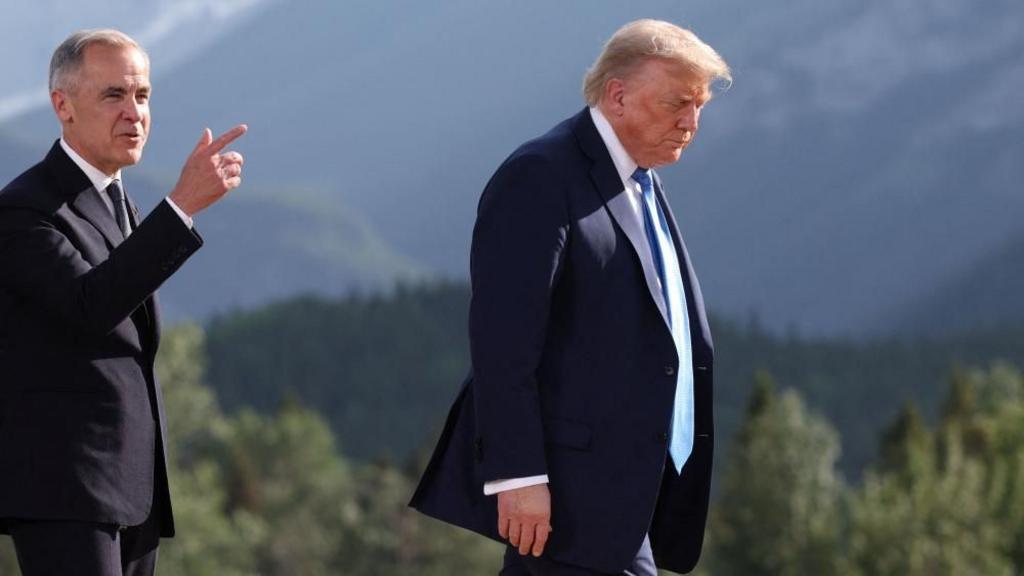A new development in the ongoing Canada-US trade tensions has emerged with US President Donald Trump threatening a 35% tariff on Canadian goods, set to take effect next month.
This announcement arrives amidst intense trade discussions between the two nations, aimed at establishing a new agreement in the coming days. The implications of this tariff threat on these negotiations remain uncertain.
Canada’s Prime Minister, Mark Carney, is now facing scrutiny regarding his ability to effectively challenge President Trump and secure a fair deal for Canada, as he pledged to do.
During April’s general election, Mr. Carney vowed to maintain an assertive stance in the face of US pressure, drawing upon a popular ice hockey analogy to describe a confrontational approach.
However, recent concessions made by Canada to the US have, so far, yielded limited results.
In late June, Canada abandoned its planned Digital Services Tax (DST) on major tech companies after President Trump threatened to halt policy negotiations.
The White House characterized Canada’s move as a capitulation, sparking debate within Canada.
Canadian commentator Robyn Urback wrote: “Maybe Prime Minister Mark Carney’s elbows were getting tired.”
She suggested the government’s fluctuating negotiation strategy could be seen as inconsistent.
Meanwhile, Blayne Haggart, a political science professor at Brock University, argued in The Globe and Mail that: “Nothing about Carney’s US strategy, particularly his pursuit of a ‘comprehensive’ trade and security agreement, makes a lick of sense.”
He argued that retracting the DST has achieved “less than nothing”.
Despite this, many are willing to grant Mr. Carney more time, and polls indicate his government retains substantial support.
Roland Paris, a former advisor to Ottawa on Canada-US relations, told the BBC that it is too early to assess whether Canada has made premature concessions.
“Much will depend on the final agreement,” he stated.
However, Mr. Paris acknowledged that President Trump is a demanding negotiator.
“If, in the end, Carney appears to have capitulated to Trump and we’re left with a bad deal, he will pay a political price at home,” he added.
Prior to abandoning the DST, Canada attempted to appease the president earlier this year by pledging C$1.3bn to enhance border security and appointing a “fentanyl czar” in response to President Trump’s concerns about the drug flowing across the border.
Despite these measures, President Trump’s recent letter announcing the latest tariff again cautioned Canada about the drug.
Mr. Carney also refrained from implementing countermeasures when the president doubled tariffs on steel and aluminium last month.
In response to the new threat of a 35% tariff by 1 August, the prime minister stated: “Throughout the current trade negotiations with the United States, the Canadian government has steadfastly defended our workers and businesses.”
He affirmed that Canada will continue negotiating, with the deadline for an agreement now revised to next month. (The two countries had previously set a 21 July time limit)
The positive aspect for Canada is that the new tariff rate will not apply, at least for now, to goods under the US-Mexico-Canada free trade agreement, which encompasses a significant portion of cross-border trade.
President Trump has also sent similar notes to over 20 countries as part of his strategy to establish new agreements with America’s trade partners.
Within Canada, there is broad political consensus against President Trump’s tariffs.
Conservative leader Pierre Poilievre stated on Thursday that his party is prepared to take every possible step “to secure the best deal for Canada”, while British Columbia Premier David Eby noted that President Trump’s letter is “one more reminder of why Canadians need to come together”.
Experts suggest there may be more to the ongoing negotiations than is immediately apparent.
Despite having a smaller economy than the US, Canada still possesses leverage, according to Fen Hampson, a professor of international affairs at Carleton University and an expert in international negotiations.
“It’s important to remember that it is American consumers who are going to pay the tariffs, not us,” he said.
Many US-based manufacturers also depend on Canadian products like steel and aluminium, which are currently subject to a steep 50% tariff.
“You can’t judge the outcome of negotiations by the last move or the concession that’s made,” Prof Hampson noted. “You can only judge it by its outcome.”
Experts also highlight Mr. Carney’s efforts to reduce reliance on the US, including signing an arms deal with the European Union, fast-tracking major projects, and removing domestic trade barriers.
Pressed Friday on Trump’s latest threat, Canada’s industry minister Melanie Joly said the government “does not negotiate in public”.
And she denied that Canada isn’t standing up to Trump.
“We’re dealing with a very unpredictable US administration,” she said, and “we’re not the only ones”.
The involuntary staff reductions are part of the Trump administration’s efforts to reduce the federal workforce.
Past visits suggest the US president’s latest trip to his mother’s homeland is unlikely to receive a warm welcome.
The White House vowed to fight the judge’s ruling, which once again paused a priority for Trump.
The new deputy director says his organisation was “totally accountable” for the violence at Trump’s rally in 2024.
Manitoba Premier Wab Kinew was critical of a letter sent by six US lawmakers concerned over wildfire smoke drifting south.

